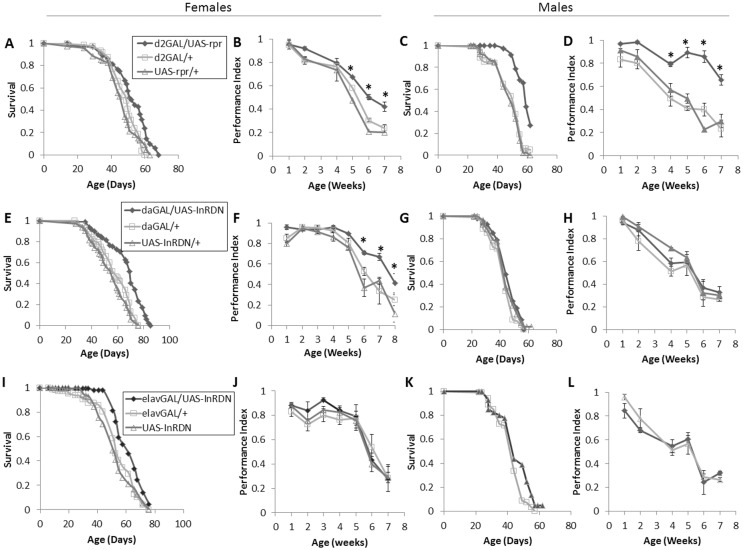Fig 1. Survival and negative geotaxis senescence in female flies with ubiquitous (d2GAL/UAS-rpr and daGAL4/UAS-InRDN) or neuron specific (elavGAL4/UAS-InRDN) reductions in IIS.
(A) Survival of d2GAL/UAS-rpr once mated female flies compared to d2GAL/+ and UAS-rpr/+ controls. Median lifespans and sample sizes were: d2GAL/UAS-rpr = 51 days, N = 71; d2GAL/+ = 49 days, N = 117; and UAS-rpr/+ = 48 days, N = 69. d2GAL/UAS-rpr showed an increased survival compared to both controls by log rank tests (P = 0.001). (B) Negative geotaxis performance index (PI) over the lifespan of d2GAL/UAS-rpr once mated female flies compared to d2GAL/+ and UAS-rpr/+ controls, N = 3 (groups of 15 flies) for each genotype. (C) Survival of d2GAL/UAS-rpr male flies compared to d2GAL/+ and UAS-rpr/+ controls. Median lifespans and sample sizes were: d2GAL/UAS-rpr = 58 days, N = 70; d2GAL/+ = 47 days, N = 80; and UAS-rpr/+ = 50 days, N = 80. d2GAL/UAS-rpr showed an increased survival compared to both controls by log rank tests (P<0.0001). (D) Negative geotaxis performance index (PI) over the lifespan of d2GAL/UAS-rpr male flies compared to d2GAL/+ and UAS-rpr/+ controls, N = 3 (groups of 15 flies) for each genotype. (E) Survival of daGAL4/UAS-InRDN once mated female flies compared to daGAL4/+ and UAS-InRDN/+ controls. Median lifespans and sample sizes were: daGAL4/UAS-InRDN = 70 days, N = 81; daGAL4/+ = 59 days, N = 84; and UAS-InRDN/+ = 56 days, N = 97. daGAL4/UAS-InRDN showed an increased survival compared to both controls (P<0.0001). (F) Negative geotaxis performance index (PI) over the lifespan of daGAL4/UAS-InRDN once mated female flies compared to daGAL4/+ and UAS-InRDN/+ controls, N = 4 (groups of 15 flies) for each genotype. (G) Survival of daGAL4/UAS-InRDN male flies compared to daGAL4/+ and UAS-InRDN/+ controls. Median lifespans and sample sizes were: daGAL4/UAS-InRDN = 41 days, N = 80; daGAL4/+ = 41 days, N = 80; and UAS-InRDN/+ = 41 days, N = 80. (H) Negative geotaxis performance index (PI) over the lifespan of daGAL4/UAS-InRDN male flies compared to daGAL4/+ and UAS-InRDN/+ controls, N = 3 (groups of 15 flies) for each genotype. (I) Survival of elavGAL4/UAS-InRDN once mated female flies compared to elavGAL4/+ and UAS-InRDN/+ controls. Median lifespans and sample sizes were: elavGAL4/UAS-InRDN = 60 days, N = 71; elavGAL4/+ = 52 days, N = 84; and UAS-InRDN/+ = 47.5 days, N = 81. elavGAL4/UAS-InRDN showed an increased survival compared to both controls (P<0.0001) (J) Negative geotaxis performance index (PI) over the lifespan of elavGAL4/UAS-InRDN once mated female flies compared to elavGAL4/+ and UAS-InRDN/+ controls, N = 3 (groups of 15 flies) for each genotype. (K) Survival of elavGAL4/UAS-InRDN male flies compared to elavGAL4/+ and UAS-InRDN/+ controls. Median lifespans and sample sizes were: elavGAL4/UAS-InRDN = 56 days, N = 105; elavGAL4/+ = 53 days, N = 89; and UAS-InRDN/+ = 56 days, N = 95. (L) Negative geotaxis performance index (PI) over the lifespan of elavGAL4/UAS-InRDN male flies compared to elavGAL4/+ and UAS-InRDN/+ controls, N = 3 (groups of 15 flies) for each genotype. Negative geotaxis data were analysed by two way ANOVA and age and genotype found to be the main effects (p<0.05). Differences between genotypes at individual time points were analysed by one way ANOVA followed by post hoc means comparisons using Tukey HSD. * indicates significant difference between experimental group and both controls, p<0.05.

